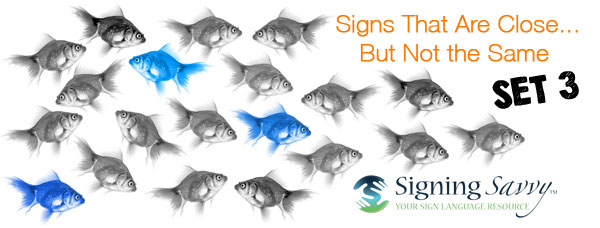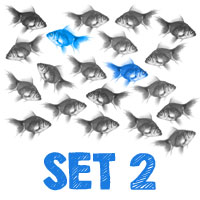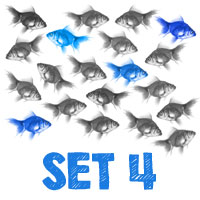
Signs That Are Close... But Not the Same - Set 3
This article is part of our “Signs That Are Close... But Not the Same” series, which highlights signs that look similar, but have different meanings.
The ASL signs shown below look similar, but are not the same. There are many ASL signs that when produced look similar, but in fact have a completely different meaning. Below you will find examples of such signs. Watch closely to see if you can see the differences. In addition, watch my eyebrows, look to see when I tilt my head or lean my body in a certain way, even what my mouth is doing. These nuances are called inflections and trust me, inflections matter.
1. Nut vs. Not
NUT and NOT both have the thumb of the dominant 10-hand come out from the face. NUT comes from the mouth, like you are eating a nut or just cracked the shell of a nut with your teeth and then spit it out. NOT comes out from the chin and moves farther away from the body in refusal. The biggest difference (besides the context of what is being said) is the facial expression and shaking of the head when signing NOT.
 |
2. Paper vs. School
PAPER and SCHOOL bring both open hands together. When signing PAPER, only the heels of both palms brush against each other in a repeated motion - think of the pressing or smashing of pulp to make paper. Clap your hands together (without making any sound) in a repeated motion to sign SCHOOL. You can remember the sign for SCHOOL by thinking of a teacher clapping her hands together to get the students’ attention.
 |
3. Name vs. Weigh
NAME and WEIGH both use H-hands. When signing NAME the two H-hands tap together twice to form an X representing a place where a name/signature would be placed on a piece of paper. When signing WEIGH both H-hands start together and the top, dominant hand tips downward representing scales tipping when weighing something.
 |
4. Teach vs. None
Flattened O-hands moving out from the body are used when signing TEACH and NONE. For TEACH, the hands come out from the head, representing the person is taking knowledge from their head and passing it on to others. When signing NONE the hands move out from the chest and away from each other in a quick fluid motion indicating that there is zero (the use of the O-hands) or nothing there.
 |
5. Roof vs. House
ROOF and HOUSE look similar but are easy to remember because both closed 5-hands form the outline of a ROOF or a HOUSE.
 |
How can I figure out the difference between signs on my own?
If you see two signs that look close, but not the same, and you’re not sure, you may use Signing Savvy features to help you figure out the difference. All of our signs have sign descriptions and memory aids that members may access. Reading the sign description and memory aids for the signs will help you figure out the small differences between them that your eyes don’t catch at first. We also recommend using the pause and slow motion feature to slow down the video, so you may take a closer look. These features are available to Signing Savvy members.
Take a look, it's in a book!
These examples are aligned with the Visual Discrimination section of Lesson 5 (page 60) from Lessons and Activities in American Sign Language by Brenda E. Cartwright and Suellen J. Bahleda. Check out the book for more ASL Activities and watch for more examples from this series: “Signs That Are Close... But Not the Same.”
Resources
Signing Savvy is a participant in the Amazon Services LLC Associates Program, an affiliate advertising program designed to provide a means for sites to earn advertising fees by advertising and linking signingsavvy.com to Amazon properties. That means Signing Savvy may contain affiliate links. If you make a purchase after clicking on an affiliate link, your cost will be exactly the same regardless, but Signing Savvy will automatically receive a small commission. Your support is greatly appreciated and helps us continue to improve Signing Savvy!
ADVERTISEMENTS
 Brenda Cartwright is a Coda, seasoned interpreter, a master teacher, well known presenter, and author of several best selling sign language and interpreting textbooks from the RID Press. For 35 years Brenda was the Chair of the Sign Language Interpreter Program at Lansing Community College in Lansing, Michigan.
Brenda Cartwright is a Coda, seasoned interpreter, a master teacher, well known presenter, and author of several best selling sign language and interpreting textbooks from the RID Press. For 35 years Brenda was the Chair of the Sign Language Interpreter Program at Lansing Community College in Lansing, Michigan. Signs That Are Close... But Not the Same - Set 1
Signs That Are Close... But Not the Same - Set 1 Signs That Are Close... But Not the Same - Set 2
Signs That Are Close... But Not the Same - Set 2 Signs That Are Close... But Not the Same - Set 4
Signs That Are Close... But Not the Same - Set 4 Signs That Are Close... But Not the Same - Set 5
Signs That Are Close... But Not the Same - Set 5 Signs That Are Close... But Not the Same - Set 6
Signs That Are Close... But Not the Same - Set 6







Savvy User SandraWednesday, November 16, 2016
I just wanted to say thank you.